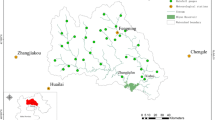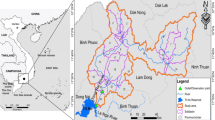Abstract
The impacts of climate change on streamflow and non-point source pollutant loads in the Shitoukoumen reservoir catchment are predicted by combining a general circulation model (HadCM3) with the Soil and Water Assessment Tool (SWAT) hydrological model. A statistical downscaling model was used to generate future local scenarios of meteorological variables such as temperature and precipitation. Then, the downscaled meteorological variables were used as input to the SWAT hydrological model calibrated and validated with observations, and the corresponding changes of future streamflow and non-point source pollutant loads in Shitoukoumen reservoir catchment were simulated and analyzed. Results show that daily temperature increases in three future periods (2010–2039, 2040–2069, and 2070–2099) relative to a baseline of 1961–1990, and the rate of increase is 0.63°C per decade. Annual precipitation also shows an apparent increase of 11 mm per decade. The calibration and validation results showed that the SWAT model was able to simulate well the streamflow and non-point source pollutant loads, with a coefficient of determination of 0.7 and a Nash–Sutcliffe efficiency of about 0.7 for both the calibration and validation periods. The future climate change has a significant impact on streamflow and non-point source pollutant loads. The annual streamflow shows a fluctuating upward trend from 2010 to 2099, with an increase rate of 1.1 m3 s−1 per decade, and a significant upward trend in summer, with an increase rate of 1.32 m3 s−1 per decade. The increase in summer contributes the most to the increase of annual load compared with other seasons. The annual NH +4 -N load into Shitoukoumen reservoir shows a significant downward trend with a decrease rate of 40.6 t per decade. The annual TP load shows an insignificant increasing trend, and its change rate is 3.77 t per decade. The results of this analysis provide a scientific basis for effective support of decision makers and strategies of adaptation to climate change.










Similar content being viewed by others
References
Arnold, J. G., & Fohrer, N. (2005). SWAT2000: current capabilities and research opportunities in applied watershed modelling. Hydrological Processes, 19(3), 563–572.
Arnold, J. G., Srinivasan, R., Muttiah, R. S., & Williams, J. R. (1998). Large area hydrologic modeling and assessment part I: model development. Journal of the American Water Resources Association, 34, 73–89.
Bates, B. C., Hope, P., Ryan, B., Smith, I., & Charles, S. (2008). Key findings from the Indian Ocean Climate Initiative and their impact on policy development in Australia. Climatic Change, 89(3–4), 339–354.
Campbell, J. L., Rustad, L. E., Boyer, E. W., Christopher, S. F., Driscoll, C. T., Fernandez, I. J., et al. (2009). Consequences of climate change for biogeochemical cycling in forests of northeastern North America. Canadian Journal of Forest Research-Revue Canadienne De Recherche Forestiere, 39(2), 264–284.
Chen, H., Guo, S., Xu, C.-Y., & Singh, V. P. (2007). Historical temporal trends of hydro-climatic variables and runoff response to climate variability and their relevance in water resource management in the Hanjiang basin. Journal of Hydrology, 344(3–4), 171–184.
Chu, J. T., Xia, J., Xu, C. Y., & Singh, V. P. (2009). Statistical downscaling of daily mean temperature, pan evaporation and precipitation for climate change scenarios in Haihe River, China. Theoretical and Applied Climatology, 99(1–2), 149–161.
Delpla, I., Jung, A. V., Baures, E., Clement, M., & Thomas, O. (2009). Impacts of climate change on surface water quality in relation to drinking water production. Environment International, 35(8), 1225–1233.
Di Luzio, M., Srinivasan, R., & Arnold, J. G. (2004). A GIS-coupled hydrological model system for the watershed cassessment of agricultural nonpoint and point sources of pollution. Transactions in GIS, 8(1), 113–136.
Diaz-Nieto, J., & Wilby, R. L. (2005). A comparison of statistical downscaling and climate change factor methods: impacts on low flows in the River Thames, United Kingdom. Climatic Change, 69(2–3), 245–268.
Dibike, Y. B., & Coulibaly, P. (2005). Hydrologic impact of climate change in the Saguenay watershed: comparison of downscaling methods and hydrologic models. Journal of Hydrology, 307(1–4), 145–163.
Fowler, H. J., Blenkinsop, S., & Tebaldi, C. (2007). Linking climate change modelling to impacts studies: recent advances in downscaling techniques for hydrological modelling. International Journal of Climatology, 27(12), 1547–1578.
Gassman, P. W., Reyes, M. R., Green, C. H., & Arnold, J. G. (2007). The soil and water assessment tool: historical development, applications, and future research directions. Transactions of the ASABE, 50(4), 1211–1250.
Ghosh, S., & Mujumdar, P. (2008). Statistical downscaling of GCM simulations to streamflow using relevance vector machine. Advances in Water Resources, 31(1), 132–146. doi:10.1016/j.advwatres.2007.07.005.
Githui, F., Mutua, F., & Bauwens, W. (2009). Climate change impact on SWAT simulated streamflow in western Kenya. International Journal of Climatology, 29(12), 1823–1834.
Graham, L. P., Andreasson, J., & Carlsson, B. (2007). Assessing climate change impacts on hydrology from an ensemble of regional climate models, model scales and linking methods—a case study on the Lule River basin. Climatic Change, 81, 293–307.
Graiprab, P., Pongput, K., Tangtham, N., & Gassman, P. W. (2010). Hydrologic evaluation and effect of climate change on the At Samat watershed, Northeastern Region, Thailand. International Agricultural Engineering Journal, 19(2), 12–22.
Hamlet, A. F., & Lettenmaier, D. P. (1999). Effects of climate change on hydrology and water resources in the Columbia River basin. Journal of the American Water Resources Association, 35(6), 1597–1623.
Hodgkins, G. A., Dudley, R. W., & Huntington, T. G. (2003). Changes in the timing of high river flows in New England over the 20th century. Journal of Hydrology, 278(1–4), 244–252.
Jha, M. K. (2004). Hydrologic modeling and climate change study in the Upper Mississippi River Basin using SWAT. Ames: Iowa State University.
Kendall, M. G. (1975). Rank correlation methods. London: Griffin.
Krysanova, V., & Arnold, J. G. (2008). Advances in ecohydrological modelling with SWAT—a review. Hydrological Sciences Journal-Journal Des Sciences Hydrologiques, 53(5), 939–947.
Lee, E., Seong, C., Kim, H., Park, S., & Kang, M. (2010). Predicting the impacts of climate change on nonpoint source pollutant loads from agricultural small watershed using artificial neural network. Journal of Environmental Sciences, 22(6), 840–845.
Limaye, A. S., Boyington, T. M., Cruise, J. F., Bulus, A., & Brown, E. (2001). Macroscale hydrologic modeling for regional climate assessment studies in the southeastern United States. Journal of the American Water Resources Association, 37(3), 709–722.
Mann, H. B. (1945). Nonparametric tests against trend. Econometrica, 13, 245–259.
Moriasi, D., Arnold, J., Van Liew, M., Bingner, R., Harmel, R., & Veith, T. (2007). Model evaluation guidelines for systematic quantification of accuracy in watershed simulations. Transactions of ASAE, 50(3), 885–900.
Muleta, M. K., & Nicklow, J. W. (2005). Sensitivity and uncertainty analysis coupled with automatic calibration for a distributed watershed model. Journal of Hydrology, 306(1–4), 127–145.
Murdoch, P. S., Baron, J. S., & Miller, T. L. (2000). Potential effects of climate change on surface water quality in North America. Journal of American Water Resources Association, 36, 347–366.
Nasha, J. E., & Sutcliffea, J. V. (1970). River flow forecasting through conceptual models: part I—a discussion of principles. Journal of Hydrology, 10, 282–290.
Neff, R., Chang, H. J., Knight, C. G., Najjar, R. G., Yarnal, B., & Walker, H. A. (2000). Impact of climate variation and change on Mid-Atlantic Region hydrology and water resources. Climate Research, 14(3), 207–218.
Neitsch, S. L., Arnold, J. G., Kiniry, J. R., & Williams, J. R. (2005). Soil and water assessment tool theoretical documentation version 2005. Temple: Grassland, Soil and Water Research Laboratory.
Park, J.-H., Duan, L., Kim, B., Mitchell, M. J., & Shibata, H. (2010). Potential effects of climate change and variability on watershed biogeochemical processes and water quality in Northeast Asia. Environment International, 36(2), 212–225.
Payne, J. T., Wood, A. W., Hamlet, A. F., Palmer, R. N., & Lettenmaier, D. P. (2004). Mitigating the effects of climate change on the water resources of the Columbia River Basin. Climatic Change, 62(1–3), 233–256.
Pellicciotti, F., Burlando, P., & van Vliet, K. (2007). Recent trends in precipitation and streamflow in the Aconcagua River basin, central Chile. IAHS Publications, 318, 17–38.
Randall, D. A., Wood, R. A., Bony, S., Colman, R., Fichefet, T., Fyfe, J., et al. (2007). Cilmate models and their evaluation. In S. Solomon, D. Qin, M. Manning, Z. Chen, M. Marquis, & K. B. Averyt (Eds.), Climate change 2007: the physical science basis. Contribution of Working Group I to the Fourth Assessment Report of the Intergovernmental Panel on Climate Change (pp. 598–662). Cambridge: Cambridge University Press.
Santhi, G., Arnold, J. G., Williams, J. R., Dugas, W. A., Srinivason, R., & Hauck, L. M. (2001). Validation of the SWAT model on a large river basin with point and nonpoint sources. Journal of American Water Resources Association, 37(6), 1169–1188.
Stone, M. C., & Hotchkiss, R. H. (2003). Water yield responses to high and low spatial resolution climate change scenarios in the Missouri River Basin. Geophysical Research Letters, 30(4), 1186.
Stone, M. C., Hotchkiss, R. H., Hubbard, C. M., Fontain, E. T. A., Mearns, L. O., & Arnold, J. G. (2001). Impacts of climate change on Missouri River Basin water yield. Journal of the American Water Resources Association, 37(5), 1119–1299.
Tu, J. (2009). Combined impact of climate and land use changes on streamflow and water quality in eastern Massachusetts, USA. Journal of Hydrology, 379(3–4), 268–283.
Whitehead, P. G., Wilby, R. L., Butterfield, D., & Wade, A. J. (2006). Impacts of climate change on in-stream nitrogen in a lowland chalk stream: an appraisal of adaptation strategies. Science of the Total Environment, 365(1–3), 260–273.
Wikipedia (2011). NCEP/NCAR reanalysis. http://en.wikipedia.org/wiki/NCEP/NCAR_Reanalysis Accessed 19 May 2011.
Wilby, R. L., Dawson, C. W., & Barrow, E. M. (2002). SDSM—a decision support tool for the assessment of regional climate change impacts. Environmental Modelling and Software, 17(2), 147–159.
Williamson, C. E., Dodds, W., Kratz, T. K., & Palmer, M. A. (2008). Lakes and streams as sentinels of environmental change in terrestrial and atmospheric processes. Frontiers in Ecology and the Environment, 6(5), 247–254.
Xu, C. Y. (1999). Climate change and hydrologic models: a review of existing gaps and recent research developments. Water Resources Management, 13(5), 369–382.
Xu, Z. X., Zhao, F. F., & Li, J. Y. (2009). Response of streamflow to climate change in the headwater catchment of the Yellow River basin. Quaternary International, 208, 62–75.
Yu, P. S., Yang, T. C., & Wu, C. K. (2002). Impact of climate change on water resources in southern Taiwan. Journal of Hydrology, 260(1–4), 161–175.
Zhang, X., Srinivasan, R., & Hao, F. (2007). Predicting hydrologic response to climate change in the Luohe River basin using the SWAT model. Transactions of the ASABE, 50(3), 901–910.
Acknowledgment
This research was supported by major projects on control and rectification of water body pollution (no. 2009ZX07526-006-04-01). Project 20101060 was supported by the Graduate Innovation Fund of Jilin University. Key Laboratory of Groundwater Resources and Environment of Ministry of Education are all gratefully acknowledged.
Author information
Authors and Affiliations
Corresponding author
Rights and permissions
About this article
Cite this article
Zhang, L., Lu, W., An, Y. et al. Response of non-point source pollutant loads to climate change in the Shitoukoumen reservoir catchment. Environ Monit Assess 184, 581–594 (2012). https://doi.org/10.1007/s10661-011-2353-7
Received:
Accepted:
Published:
Issue Date:
DOI: https://doi.org/10.1007/s10661-011-2353-7




